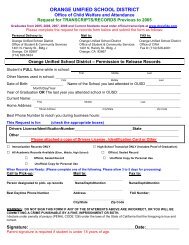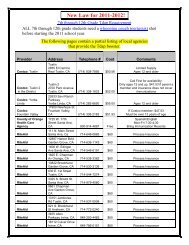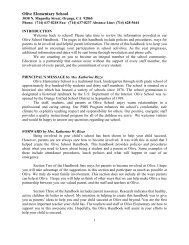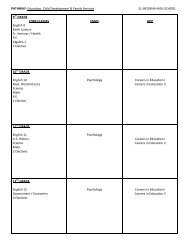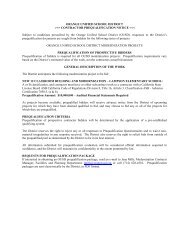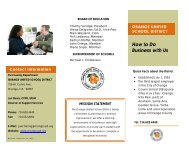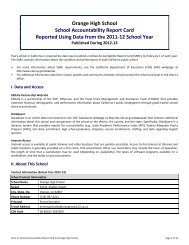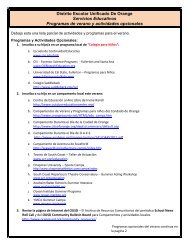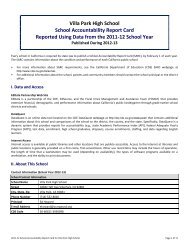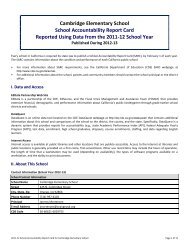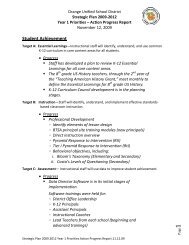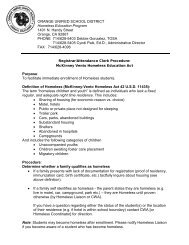Hot Weather Guidelines for Schools - Washtenaw County
Hot Weather Guidelines for Schools - Washtenaw County
Hot Weather Guidelines for Schools - Washtenaw County
You also want an ePaper? Increase the reach of your titles
YUMPU automatically turns print PDFs into web optimized ePapers that Google loves.
<strong>Hot</strong> <strong>Weather</strong><br />
<strong>Guidelines</strong><br />
<strong>for</strong> <strong>Schools</strong><br />
Children take longer to adjust to hot environments than adults do, and<br />
their bodies reach core temperature much faster. Children’s bodies have<br />
greater surface area to body mass ratio, so they absorb more heat on a<br />
hot day (and lose heat more rapidly on a cold day). Also, children have<br />
considerable lower sweating capacity than adults, and so they are less<br />
able to dissipate body heat by evaporative sweating and cooling.<br />
Children are less likely to feel thirsty during prolonged play and exercise,<br />
and sometimes they just don’t want to be interrupted. They need to be<br />
reminded to drink water or another beverage.<br />
The Orange <strong>County</strong> Department of Education in collaboration with the<br />
Orange <strong>County</strong> Health Care Agency have created the following guidelines<br />
<strong>for</strong> schools to increase student safety during periods of hot weather.<br />
** When outdoors, stay in the shade whenever possible. Limit time<br />
outdoors when temperatures and UV radiation are most intense,<br />
between 11 a.m. and 4 p.m.<br />
** Ensure children are well hydrated. Provide or encourage frequent<br />
drinks to ensure adequate hydration. Plain water is the liquid of<br />
choice.<br />
** Monitor children in wheelchairs and check the temperature of metal<br />
and vinyl parts.<br />
** Check the temperature of metal and plastic playground equipment.<br />
** Staff should be aware of the signs and symptoms of heat cramps,<br />
heat exhaustion, and heat stroke. Follow first aid procedures<br />
promptly.<br />
** Limit strenuous activity outdoors<br />
Check regularly on young children and those children who are<br />
**<br />
physically challenged or in wheelchairs and those who have<br />
chronic illnesses such as asthma.
Heat Illness<br />
Signs and Symptoms<br />
Sunburn: Redness, pain, swelling of skin, blisters, fever and headaches.<br />
Treatment: leave water blisters intact to speed healing and avoid infection. If blisters<br />
break, apply a dry sterile dressing. Refer serious cases to a physician.<br />
Heat Cramps: heavy sweating can cause painful muscle cramps, usually in the legs, but<br />
possibly in the abdomen.<br />
Treatment: apply firm pressure on cramping muscles or gently massage to relieve<br />
spasm; give sips of water, if nausea occurs discontinue sips of water, move person<br />
to a cooler place to rest. Observe the person carefully <strong>for</strong> changes in condition.<br />
Heat Exhaustion: heavy sweating, weakness, cold, pale and clammy skin; weak pulse,<br />
fainting and vomiting.<br />
Treatment: get person out of sun, move person to a cooler environment, lay person<br />
down and loosen clothing, apply cool wet cloths, give sips of water. If nausea occurs,<br />
discontinue sips of water; if vomiting continues, seek immediate medical attention.<br />
Heatstroke: severe medical emergency, hot, dry skin, rapid and strong pulse, possible<br />
unconsciousness.<br />
Treatment: Call 911, if unable to get person to medical help immediately,<br />
do the following:<br />
* Move person to a cooler environment<br />
* Remove outer clothing<br />
* Reduce body temperature using lukewarm (not cold) water to<br />
bathe/sponge the person<br />
* Do not give fluids<br />
Activity<br />
<strong>Guidelines</strong><br />
Fluid breaks should be scheduled <strong>for</strong> all practices and become more frequent as the heat and<br />
humidity levels rise.<br />
Add 5˚F to the temperature between 10:00 a.m. and 4:00 p.m. from mid-May to mid-September<br />
on bright, sunny days.<br />
A.<br />
B.<br />
Children should receive<br />
a 5-10 minute rest and<br />
fluid break after every<br />
25 to 30 minutes of<br />
activity.<br />
Children should receive<br />
a 5-10 minute rest and<br />
fluid break after every<br />
25 to 30 minutes of<br />
activity. Children should<br />
be in shorts and t-shirts<br />
(with helmet and<br />
shoulder pads only,<br />
not full equipment,<br />
if worn <strong>for</strong> activity).<br />
Relative Humidity (%)<br />
100<br />
90<br />
80<br />
70<br />
60<br />
50<br />
40<br />
30<br />
20<br />
10<br />
0<br />
70 74 78 82 86 90 94 98 102<br />
Temperature (°F)<br />
C.<br />
D.<br />
Children should receive a<br />
5-10 minute rest and fluid<br />
break after every 15 to 20<br />
minutes of activity.<br />
Children should be in<br />
shorts and t-shirts only<br />
(with all protective<br />
equipment removed,<br />
if worn <strong>for</strong> activity).<br />
Cancel or postpone all<br />
outdoor practices/games.<br />
Practice may be held in<br />
an air conditioned space.



